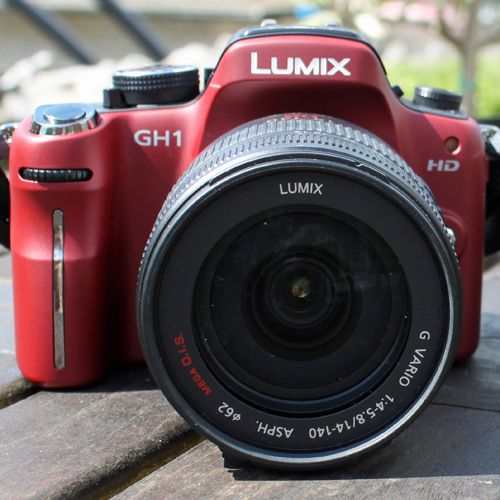Panasonic beat its development partner Olympus to market with the first camera in its new Micro Four Thirds system. The G1 was styled like a DSLR but wasn’t really, having done away with the internal mirror mechanism to bring lens and sensor even closer together.
Olympus has since responded with a totally different yet technically similar concept in the retro-look Micro Four Thirds E-P1 (or digital "Pen"). Which makes the introduction of Panasonic’s new 12.1-megapixel GH1, introducing HD video capture for the first time to the G Micro range, seem almost conventional by comparison.
As with Olympus, the sales pitch here is "compact dimensions yet DSLR image quality". But, as with the G1 and E-P1, it’s not a DSLR as it doesn’t feature an internal mirror … still with us?
Available in a choice of three colours – we had the maroon red - the dimensions of the GH1 ensure that size-wise it sits between the E-P1 and the compact likes of Sony’s APS-C format A380 starter DSLR. So by any standards the Panasonic is relatively unobtrusive, even if it won’t easily fit in any pocket save that of a poacher’s coat.
The camera is being sold with the chunky optically stabilised, quiet in operation 14-140mm zoom we had for our test period, giving the equivalent of 28-280mm in 35mm terms, or a 10x zoom. Its anti-shake equipped lens is a bonus, as the camera doesn’t feature image stabilisation built into the body as one might otherwise expect. So, as with a bridge model, this then could be the only lens most consumer users might ever need; but doesn’t that rather defeat the purpose of an interchangeable lens camera?
Pick the GH1 up with said optic in place and the combination feels reassuringly weighty and solid in the palm, aimed as it is at advanced amateurs with a surprisingly hefty UK price tag in the region of £1300.
The second thing noticed is that the camera feels like it has be enshrouded in suede, or at least a very tactile smooth rubber outer coating, that aids gripping. The moulded grip itself is sufficiently large to wrap two or three fingers around, while your thumb rests on a pad at the back, with red video button inset, and your forefinger hovers over the shutter release button. The build quality then is impressive, but so it should be at this price.
The GH1 feels fractionally chunkier than the G1 too, with a stereo microphone sunk into the hood for the pop-up flash to make its introduction of AVCHD format (or Motion JPEG, you decide) Full HD 1920 x 1080 pixels, 24 frames-per-second video all the more enticing. For those looking for more professional results still, an external microphone can also be added if desired.
What’s unusual here also is that the camera automatically adjusts focus when shooting video – so the user isn’t constantly having to manually tweak the shot as they zoom in or out.
As an aid to composition, the GH1’s rear 3-inch, 460k dot LCD can be rotated, angled and tilted, or, for added protection, turned screen inwards to the body. Helpfully it automatically adjusts visibility according to ambient light levels. There’s a dedicated button for users to swap between using the larger monitor or the smaller electronic viewfinder – or rather Live View(finder) - above. Both provide a 100% field of view and a commendably crystal-clear, largely flicker free image. The impression given is of an extension of your own eye.
As with Panasonic’s Lumix range of compacts, included here on the 14-option shooting mode wheel is an intelligent Auto (iA) mode that allows less confident users to point and shoot to begin with, the camera theoretically choosing optimal settings which it adjusts upon recognising the scene or subject it’s presented with. Otherwise, users wanting to get more hands on still have the more creative quartet of P, A, S, M.
Panasonic has described the GH1 as a ‘hybrid’ camera, and that could both be interpreted as a best of both worlds solution between a compact and a DSLR, or a stills camera and a camcorder.
Thanks in part to the provided lens, results are impressively sharp and realistically coloured whichever format you choose to use – plus the broad focal range proves extremely useful, whether for shooting candids or simply getting closer to your subject – particularly in the case of skittish wildlife – than would otherwise be possible.
In terms of the handling (or otherwise) of image noise, with excellent results up to and including ISO 800, it’s only really at ISO 3200 that fine banding starts to intrude and its effects are more obvious.
Our quick take
Ultimately though, the biggest hurdle for the GH1 is its cost. Although the asking price of nearly £1300 includes that very decent spec lens, that’s still quite a big ask of the "advanced amateur". Its manufacturer might argue that the set-up will be all most will ever need, yet if you don’t need video or the longer lens, the G1 predecessor now looks considerably better value.
Though Micro Four Thirds is a fledgling system, a 7-14mm ultra wide angle zoom was announced at the time of the GH1’s launch back in March, and more optics are promised as we move through the year for those brave enough to dive in.
While it’s difficult to know who the GH1 will presently appeal to, given its semi-pro price tag (against which both its own G1 and - if video is crucial - Olympus’ E-P1 are looking the better option) the hybrid camera performs well and is more than pleasant to use.

Panasonic Lumix DMC-GH1 camera - 4.0 / 5
| FOR | AGAINST |
|---|---|
|
|
To recap
While it’s difficult to know who the GH1 will presently appeal to given its semi-pro price tag, the hybrid camera performs well and is more than pleasant to use
